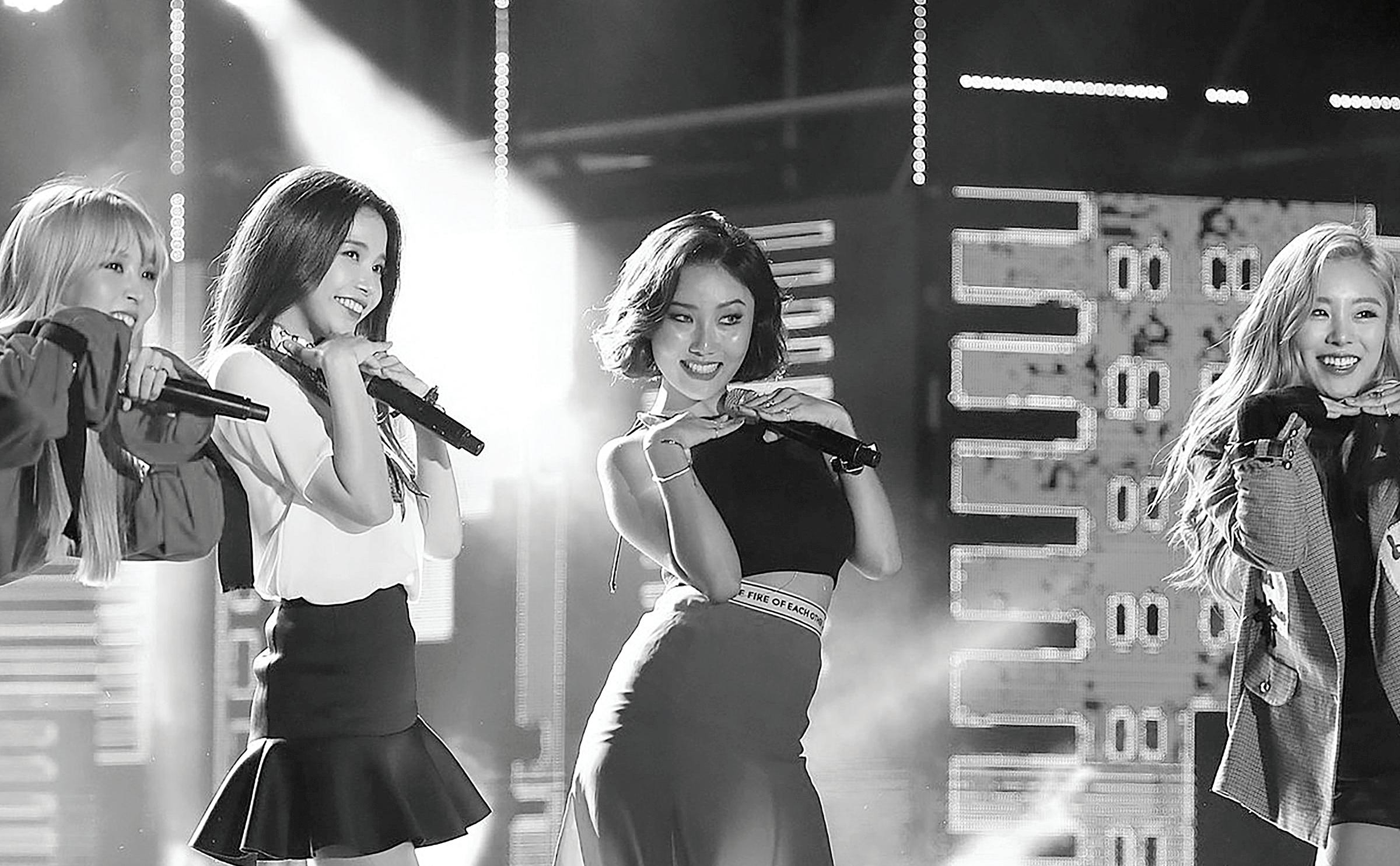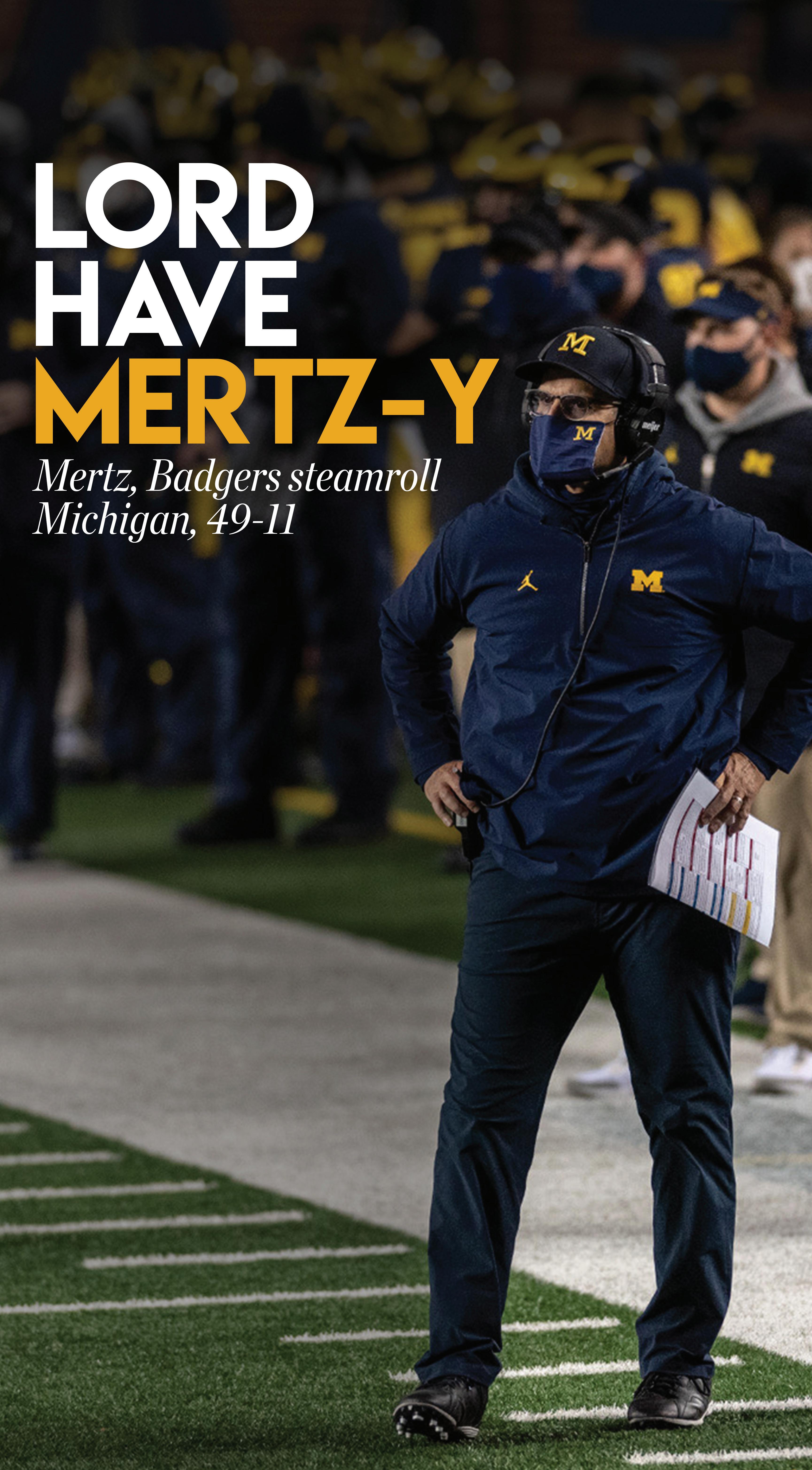Arts
The Michigan Daily — michigandaily.com
Wednesday, November 18, 2020 — 13
The K-pop queens of vocals stage a forgettable return JASON ZHANG For The Daily
The goddesses of vocals, Mamamoo, return for their crown with their new minialbum, Travel. Their recent track of success with “HIP” and Hwasa’s “Maria” created incredibly high expectations for this album. Aptly titled, the project takes inspiration from a plethora of music from around the world, ranging from the ’70s aesthetic in the U.S. to traditional Middle Eastern music. They were quite adventurous with their internationally inspired stylistic choices; some of them were used to a great synergistic effect, although other times the results sounded tacky. While their vocals are perfect, as always, there is an overall sense of complacency and mediocrity across the album — two things that do not represent Mamamoo well at all. The mini-album begins with “Travel,” a laid-back, chill
summer-bop with the cliché high-pass filter. It’s nothing revolutionary. Moonbyul’s melodic rap perfectly weaves in and out of the otherwise very ordinary and basic song. The song has the classic Mamamoo slowed-down beat rap verse in the middle of the
While their vocals are perfect, as always, there is an overall sense of complacency and mediocrity across the album — two things that do not represent Mamamoo well at all.
song, then ramps back up to the chorus. Even the bridge is very formulaic, the instrumentation is more sparse and the vocalists trade lines. Overall, “Travel” is as forgettable as it is unoriginal.
The next song makes up for it, though. “Dingga” is everything “Dynamite” by BTS wished it was. The bouncy bassline is infectious and invites the listener to groove with the song. Strings join in for the chorus which has a really full and rich sound, and it’s really groovy. It combines bass drum hits on every beat with syncopated disco elements that create a compelling rhythmic drive. Hwasa’s and Wheein’s voices lend well to this song, as Hwasa brings her sexy sultry style, and Wheein really comes into her own as a distinct voice in the group. The title track, “Aya,” seems to rely more on the word “Aya” than an actual melody to be catchy. The flute motif of “Aya” pervades throughout the song and carries it melodically (I definitely can see it becoming the subject of many TikToks and memes). The build-up of the pre-chorus to the chorus generates great expectations, but the anti-drop of the chorus is anticlimactic and disappointing. The third and fourth verses are the silver lining of the song. The
WIKIMEDIA COMMONS
introduction of the low brass in the beat gives it a sort of Latin pop flavor — it’s definitely a killer combination. The faster tempo dance break seems tacked on, like a last-ditch effort to generate some sort of variety within the song, and the ending is sudden and dissatisfying. “Chuck,” “Diamond” and “Goodnight” carry the album. “Chuck” is a unique sound for K-pop: It starts with a breathy, raspy, quieter singing style complemented by a stripped back synth beat. The chorus features heavier instrumentals, but it’s incredibly catchy. It is such a dramatic and effective sound when the group harmonizes and slides up to a chord, and it really
showcases how wonderful they are as vocalists. “Chuck” also highlights a sexier side of Solar’s voice that we really only got a glimpse of in her single “Spit it Out.” “Diamond” is badass. The beat is slow but confident. The lyrics are slurred and seem to form one long string of beautiful melody. There are some really funky harmonies in there too — the pre-chorus to the chorus shifting from the G major to A major 7 gives a dreamy, ethereal quality to the music. The queens of the emotional ballad strike again with “Good Night,” and do not disappoint. In an oversaturated field, filled with incredibly talented K-R&B artists, Mamamoo
still manages to stick out. Mamamoo fills the song with their angelic voices, and heaven may actually sound like this. Travel fails where it needs to succeed; its most important songs, the first and the title track, are lackluster and leave a lot to be desired. The other songs on the album are fantastic but don’t quite make up for it. Mamamoo has consistently been putting out music throughout quarantine, and frankly some of the songs on this album sound like they are burnt out. Maybe they should take a well-deserved break. Daily Arts Writer Jason Zhang can be reached at zhangjt@umich.edu.
‘The Shadow King’ on our memory of war, violence ELIZABETH YOON Daily Arts Writer
The author of one of the Guardian’s “10 Best Contemporary African books” has made a triumphant contribution to the literary world with her pre-WWII epic “The Shadow King.” Shortlisted for the Booker Prize for Fiction, Maaza Mengiste remakes and rebirths Homeric mythology in 1930s Ethiopia, embarking on an evaluation of war, trauma and memory. Covering a lightly fictionalized Second Italo-Ethiopian War, Mengiste documents Mussolini’s invasion of Ethiopia and the people’s resistance. Usually war novels attempt to hold your heart and emotions hostage, harming you with an onslaught of devastating events. However, Mengiste’s novel is a beautiful and relatively nontraumatic read. Pulling from both history and Greek tragedy, Mengiste transforms her forgotten conflict into a new Iliad, complete with capricious higher powers, irresponsible kings and fighting women. By including mythic elements (repeated Greek chorus chapters, allusions, etc.), Mengiste helps muffle the dark topics native to wartime: war, rape, assault, extreme violence. On one side, fascist Italy is ramping up their late imperialism. With better weaponry and technology, the Italians hope for an easy victory. However, Ethiopia is not an easy prize to be won, plundered and stolen. Out of necessity and national pride, Ethiopian generals and households rally for war, echoing the Greek Basileus (kings) who kept their oath to retrieve Helen of Troy in Homer’s “The Iliad.” The epic begins with the main character Hirut fingering through a box of photos taken by an Italian war photographer. Through the pictures, Hirut and Mengiste recall trauma and violence. And it is through Hirut that Mengiste interrogates how one can physically survive battle and emotionally cope with its trauma. Hirut begins untouched and unmarred before the beginning of the war. She lives a small existence on the edge of an Ethiopian estate. Having lost
her parents, she has seen little of the world beyond the estate she works on. Over the course of the novel, her naivete hardens and she evolves into a soldier. However, Hirut is an abnormal protagonist. Mengiste is not pracious with Hirut. Often, her narrative leaves Hirut behind to explore other, more interesting characters. In one scene, Hirut is pointedly ignored by two embracing characters. While another author might delve into Hirut’s feelings of rejection and confusion, Mengiste does not indulge Hirut. Hirut is not clever or particularly pretty. She is not the center of the story. By excluding Hirut’s feelings from the narrative, Mengiste signals that Hirut herself is tertiary to the larger tapestry of war, plunder and Ethiopia being woven. Menguste’s disregard for
Is there a way to escape war physically and mentally intact? Are there metaphysical human conditions that get torn out of ourselves during wartime? Hirut is brilliant. It’s one of the most daring literary choices made by an author in a long time. Goodreads reviews reacted to Mengiste’s tactical disregard by taking umbrage, misinterpreting Mengiste’s distance from Hirut as negligence. Usually, main characters are celebrated or special in some way. Mengiste does not coddle Hirut or indulge her thoughts and hopes. Instead, Mengiste deposits the same opaque, archetypal figures from myth into her story. Just as you do not know Achilles or the Euripides’ constant thoughts, you are similarly shut out from Hirut’s perspective. Like Homer and Aeschylus, Mengiste makes you privy to Hirut’s primal rage and confusion but keeps her psychology a secret. She does this to cleave Hirut and the Ethipidans closer to legend. She forces the audience to observe and question the impact of violence and wartime.
If enduring is only one way through violence, how can we ensure that the violence doesn’t pillage our bodies and person? Is there a way to escape war physically and mentally intact? Are there metaphysical human conditions that get torn out of ourselves during wartime? As a contrast to Hirut, Mengiste also follows Ettore, a Jewish Italian war photographer whose psyche and psychology is very clearly laid out. He is an invader on the other side of the war, commissioned to photograph the triumphant Italians. But within the war and the Italian front, he is unsafe. Anti-Jewish sentiment seeps from Italy into Ethiopia and Ettore is anxious and morally conflicted about the atrocities commited against the Ethopians. However, paralyzed by fear that Italy’s violence will be turned against him, Ettore tries to keep his head down as he documents the war. At his best, Ettore is uncomfortable. At his worst he is complicit. Whereas Hirut and her cohort become immortalized, Ettore remains desperately small and human, a witness to others’ greatness. If Hirut and the Ethiopians represent the subjects of the mythology, Ettore is the scribe. Continuously taking photos and documenting the war, Ettore keeps the themes of legacy and legend alive. His photography facilitates the Second Italo-Ethiopian War’s transformation into a legend, using his camera and viewfinder to create main characters and sell a narrative to Europe and Ethiopia, producing propaganda and stories to sate curiosities. Mengiste, through a variety of angles, transmutes her novel and national history into a myth. Whereas most myth retellings try to turn the myths into a novel, Mengiste does the reverse. She immortalizes the fighting females of Ethiopia in the form of lyrical prose. She constantly and cleverly embeds allusions and includes a Greek chorus in her novel, planting a consciousness of legacy and legend. Startling, mythic and vivid, Mengiste’s novel wakes up your senses without harming you. Daily Arts Writer Elizabeth Yoon can be reached at elizyoon@ umich.edu.
Finding warmth in Charlie Brown holiday specials
PIXY
JUDITH LAWRENCE For The Daily
To say that this past week was stressful is an understatement. I found it difficult to focus on anything, whether it was homework or watching a lecture for more than 30 minutes. But recently I’ve rediscovered something very special: the Charlie Brown holiday specials. I know these are important parts of the holidays, but for whatever reason I had completely forgotten about them — until now. It is wonderful that there are three specials for three notable holidays of the fall and winter (Halloween, Thanksgiving and Christmas), especially because they’re perfectly spaced out. In October I watched “It’s the Great Pumpkin, Charlie Brown,” and this weekend I watched “A Charlie Brown Thanksgiving.” I thoroughly enjoyed both and was smiling the whole time through. I’m used to watching Disney-Pixar movies where the animation is crazy detailed and creepily realistic. Charlie Brown is the opposite of this, but to me, it’s still incredibly immersive. Movies like “Monsters Inc.” and “Toy Story” are gorgeous and comforting in their own right, but Charlie Brown feels particularly nostalgic. Its simplistic animation is whimsical and
endearing, and I think part of Charlie Brown’s everlasting charm. There’s a reason Charlie Brown has remained a favorite for so many after all this time. It’s rather obvious what makes these specials so delightful, but since I hadn’t watched either of them in so long, I was surprised at how much I still liked them. The animation and color palette are beautiful and feel like
Full of nostalgia and joy, these Charlie Brown specials are a sure-fire way to lift anyone’s spirits, and who doesn’t want that?
they’re right out of the comics. That silly spirit is captured so well through the icons that are Charlie Brown, Lucy, Sally, Snoopy and more. They exist in a world where their parents’ voices are replaced by a muted trombone. These specials are solely from the perspective of children. This adds to their dreamlike quality, making them truly feel like an escape. One thing that absolutely defines these specials is Vince
Guaraldi’s music. Guaraldi initially composed for Charles M. Schulz for a documentary about the Peanuts comics called “A Boy Named Charlie Brown,” and since then he has become integral to the Charlie Brown legacy. After watching the specials, I found myself putting the soundtracks on while I studied because they’re so peaceful. I also appreciate how short these specials are. At 30 minutes each, watching one of them is not a big commitment. Finding time to watch anything is difficult, and especially at times when focus is hard to come by. During election week in particular, anytime I tried to sit down and relax I was instantly distracted by my phone to check the polls. “A Charlie Brown Thanksgiving” is only 30 minutes, and it goes by so quickly! As soon as December comes, I’m going to watch “A Charlie Brown Christmas,” and I highly suggest that you do too. We’re all unsure what these coming months will look like. This semester has been so different from what it should have been, and I know I’ve been trying to find ways to make things feel normal. Full of nostalgia and joy, these Charlie Brown specials are a sure-fire way to lift anyone’s spirits, and who doesn’t want that? Daily Arts Contributor Judith Lawrence can be reached at judelaw@umich.edu.
“ t l T
g s v D a i





